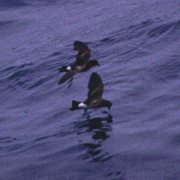Wilson's Storm-Petrel
Oceanites
oceanicus
Procellariiformes
The tube-nosed seabirds, as this group is sometimes called, spend much of their life on the high seas out of sight of land, gleaning food from the water's surface. For most, the nesting season is the only time of the year that they touch land. They are drably colored—usually gray, black, or brown, with white—and range in size from small to very large. External nostrils on the upper mandible endow these birds with an unusually well developed sense of smell and contain a gland used for excreting salt. The order has four families worldwide, of which three are represented in Washington:
Hydrobatidae
The smallest of the seabirds, the storm-petrels are usually predominantly dark brown or black, with white or light markings. Several species are mostly gray, including one species in the north Pacific. Many are migratory, and all are nocturnal at the nesting colonies. They fly very close to the water, and much of their feeding is done in flight. Incubation time and the time from hatching to fledging are highly variable because bad weather may prevent the adults from returning to the nest for several days. Eggs can hatch even if incubation is interrupted for up to 25 days, and young can survive extended periods of time between feedings, up to three weeks, by going into torpor, a sort of mini-hibernation to save energy. The ability of the egg to survive with suspended incubation and for the chick to become torpid are important for survival, since the adults spend a lot of time away from the nest looking for food that can be hard to find.
General Description
Two records, both off Westport (Grays Harbor County), July 1984 and September 2001.





